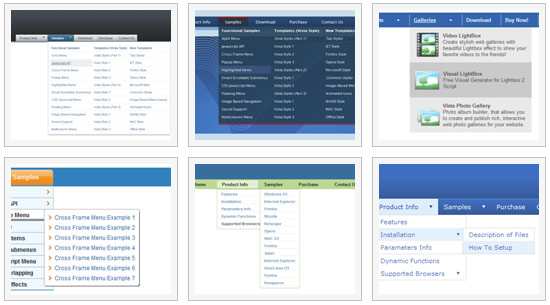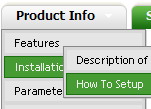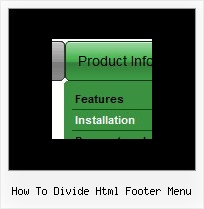Recent Questions
Q: I was testing your suite and I like it very much, but I do have problems with IE 7 (last updates) on a winXP Pro machine. The javascript menu sample doesn't show up on the site. Do you know something about this or can you tell me what I have made wrong? I tried the normal export and also the export code for search friendly sites.
Please give me a short hint, what I must change.
Looking forward in hearing from you soon
A: Try to set exact width for the menu.
var menuWidth="400px";
Q: I have a question about your code for drop down menu; I was searching the internet for some programs that could generate a good menu for me. I came across your program deluxe tuner. It said it was freehowever it seems as if you need another program to get this one to work although it looks like deluxe tuner does everything I need to do. Anyways I am having a serious issue. The program generates the navbar perfectly fine, the problem is getting it to import into my web page. I tried the instructions below in dreamweaver CS3 severaltimes. I then tried to do it to a blank web page still nothing. I go into the source code and paste the code that this program generates exactly where I am told to place it then I also place the other code where I would like the navbar to be. Nothing happens I preview my site and I just get a blank page??? I placed the source files under the root of the web folder; I double checked the code to make sure that it is pointing to the source files. The Main .Js file sits in the root folder the same folder that the page is in, and the other .js files sit under a folder called “ NavBar.files “ that deluxe tuner generated for me.What could I possible be missing?? If I need to pay for the program I defiantly will but not until I get an answer on this question.
A: Your installation seems to be correct.
Please, check that you have all files for the code for drop down menu in the correctplaces, for example:
NavBar.files/
dmenu.js
....
*.gif
...
index.html
NavBar.js
Try also to set exact width for the code for drop down menu, for example:
var menuWidth="400px";
Q: I’m looking for a popup multilevel menu. I think from your website that your menus will do this for but I can’t figure out using the trial version how to do it.
I have an image map of a graphic and I need to call my javascript pop out menu from an OnMouseOver in the image map…
<areahref="#"onmouseover=""shape="rect"coords="120, 124, 180, 136">
Obviously I can’t put the standard <script>… as described in your sample.
Is there a setting that I need to change or is this not possible with your javascript pop out menu.
A: You can try to use Popup Menu, see more info:
http://deluxe-menu.com/popup-mode-sample.html
See how you should call pop up menu
<img src="data-samples/images/popup_pic.gif" width=180 height=119 onmouseover="return dm_popup(0, 2000, event);" onClick="return dm_popup(1, 2000, event);" style="cursor: pointer;"><br>
You can create your javascript pop out menu using Deluxe Tuner application.
Q: Is there a way to hide a menu options in the navigation menu using either CSS or the java api based on the site user?
A: Deluxe Menu supports Javascript API.
You can find more info here:
http://deluxe-menu.com/dynamic-functions-sample.html
You can try to use API functions in that case:
function dm_ext_changeItemVisibility (menuInd, submenuInd, itemInd, visibility)
To disable items you should set the target parameter to "_".
You can try to use the following function
function disable() {
dm_ext_changeItem(0, 1, 1, ["", "", "", "", "", "_"]);
}
to disable your items.










